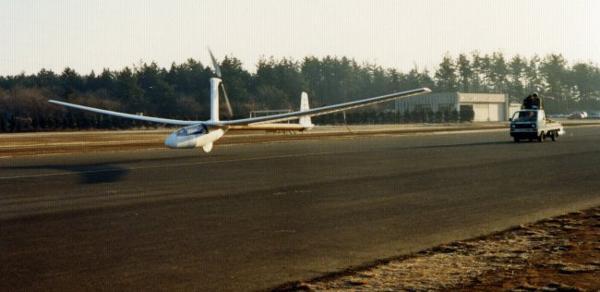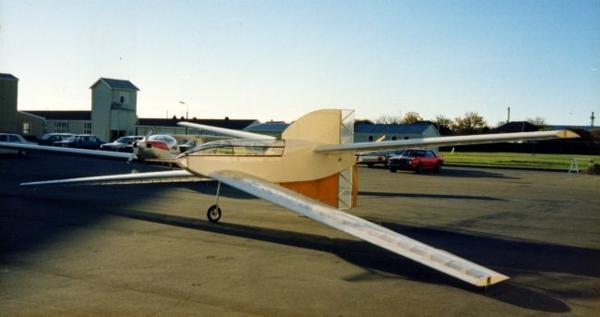Other 80's Planes
RAVEN
Paul Illian, also a member of the Flight Research Institute of Seattle proposed a development of Man-Eagle. The fuselage shape was to be computer generated. Several HPA had been built with the propeller shaft at the same height as the pedal shaft. This had necessitated a high undercarriage, and some of these planes had not flown. To make this layout practical, he suggested a retractable undercarriage. Illian's other justified criticism of most past designs is that Mylar did not provide the correct profile shape between the ribs. It is also true that the glass-cloth stiffened foam sheet that had been used had not held its exact shape under load either. With Bliesner's experience, and Illian's new ideas, it appeared at the outset that we were about to see a very interesting new HPA. A flight-simulator was built which was linked to the special program that Paul had written. Your author had the experience of using this simulator in 1994. I found that I could not adapt to the prone position on this simulator and found it difficult to exert much pedal-power. It would seem that the further back that the pilot leans, the more critical it is to tailor the seat to the individual. Illian and his team elicited support from many firms and academies. Sophisticated techniques were used in manufacture of components, many of them "sub-contracted" to the supporting organisations. The Raven project has its own highly artistic website . However, flight results were dissapointing. The airframe suffered from structural defects.
SWIFT series
These aircraft were built by students at Nihon University to compete for the Kremer World Speed Competition. Swift A had the configuration of a high-performance sailplane. The pilot was recumbent with the propeller on a pylon above the wing. Structure was carbon and foam. The Swift B and the subsequent Swift C had configurations similar to Musculair. The transmission was twisted chain, 1/2 inch (12.7 mm) pitch Shimano bicycle chain. Many different chains have been used on a twisted drive for HPAs. Any chain will be able to accomodate a certain twist per length, but this Shimano was found to be excellent. Innovative on this Japanese aircraft was the use of two skeins of rubber inside a larger-than-usual tail-boom to provide energy-storage after the principle of a model-aeroplane. 13lbs (5.9 Kg) of 1/4 inch (6 mm) model-aeroplane-rubber were used. Pilot Koichi Nakamura said in 1990 that these aircraft were nice to fly and had good controllability; however no official entries were made for the speed competition..
Swift A flying in 1983. RAeS collection
NEW ZEALAND
There have been three projects in New Zealand, all of unconventional configuration; two of the aeroplanes made flights under tow.
FROST EMMETT HPA 197? -1979 and 1984
The machine was partly constructed in the 1970s by John Frost. The structure was aluminium tube with a maze of bracing wires and control was by wing-warping, similar to the Condors of the same period. The wing was covered with Dacron, a heavier material than Melinex, and the wing-area was only a third of the Condor. Span was 80 ft (24.4 m) with a wing area of 250 sq ft (23.2 m2), and empty weight was 92.4 lb (42 Kg). Configuration was flying wing. Frost died in 1979 before the craft was complete and the machine became the property of the Auckland branch of the RAeS. In 1983 it was handed over to University of Auckland.
UNIVERSITY OF AUCKLAND 1984
In 1984 Grant D. Shirreffs and Daniel S. Steinemann of the University of Auckland made a two-pronged attack on the problem of HPF. One was to complete and test the Emmett HPA and the other was to further develop the propeller design algorithm of Prof. Larrabee mentioned above.
Flight trials at RNZAF Base Auckland, Hobsonville, were made with the aircraft towed behind a car. The aircraft proved extremely difficult to fly. Lateral control was totally inadequate, and a wingtip dropping on take-off could not be corrected. Shirreffs reports " This control mechanism would not be recommended for future HPA" . However he recognises that ".. the structural design concept was arrived at simultaneously by MacCready and Frost ...".
PROPELLER DESIGN
A Fortran computer-program was written for minimum induced loss propeller design. Shirreffs notes the difficulty in obtaining aerofoil data for angles of incidence beyond the stall. A listing of this program is in Shirreffs report to the University. (Report PME 84/041, Department of Mechanical Engineering, University of Auckland)
NZHPFG "ROYAL SPOONBILL" HPA 1983 to 1987
This ambitious design was for a three-seater aircraft, the pilots in separate pods, like the Newbury Manflier. Proposed wingspan for the "Royal Spoonbill" was 328 ft (100 m). Robert Le Johnno-Johnson initiated the "New Zealand Human Powered Flight Group", or "Squadron" in 1983. He applied to the RAeS for entry into Kremer Competitions on headed notepaper and challenged the Daedalus to a race. The group built special workshop equipment including a vacuum-table for curing resin on Kevlar tubes and angle joints, but not all of the Royal Spoonbill ever existed as hardware. When the plane was quarter built in 1985, the workshop was vandalised. At this stage the group took the opportunity of a redesign. However, the workshop was closed down and the squadron disbanded on 12th March 1987.
DON WALTHER 1982 to 1987
Don Walther of Christchurch, New Zealand was an ex-RNZAF-pilot. Between 1982 and 1987 he built a machine called the "Boffin Coffin". This machine had a wingspan of 45 feet (13.7 m). The planform was unconventional, with a forward wing of 140 sq ft (13 m2)and a rear-wing of 120 sq ft (11 m2). Weight was 126 lb (57 Kg), materials were resin-laminated aluminium-alloy sheet, EPS and Melinex. Pilot position was prone, i.e. head first. There was a shock absorber in the drive between the rear-wheel and the prop. Flight trials were made at Wigram Air Base Christchurch with a car towing the plane. After the first flight, piloted by 65 year old Walther, he said ".. when I took my eyes off the tiller and looked down I was looking down on the roof of the car. The aircraft came down very lightly, but I could hardly call it a controlled flight. It is a mystery just how much control there is with these ailerons on the front wing - how much they contributed to my safe landing and how much was pure luck.". Even the three foot long main undercarriage leg survived this first landing, but after its second launch it landed tail-first causing damage. Further flight attempts were made in 1987 under pedal-power by younger pilots, Steven Preest and Trent Hiles. Don Walther writes (January 1990), " The steady easterly breezes which blow over Wigram Airbase make it unsuitable for HP flights. " Even in the hangar " The hangar doors had been left open and a blast of wind shot the machine backwards into a wall. I gave up repairing ", as in any event ," it received damage from time to time by people not familiar with the delicate nature of these aircraft.". Walther abandoned the project in July 1988.
To date, the only human powered flight south of the equator has been the single flight of the Vine in Africa in 1962. (what about the Skycycle in Tasmania? - Editor)
Boffin Coffin. RAeS collection
VERTIGO
Andrew Cranfield was working at Westland Helicopters, England in September 1980 when he started design of a human-powered helicopter. This had four rotor blades, two pairs contra-rotating. The pilot was on a bicycle-style seat frame above the blades in order to get the most ground effect. Rotor diameter was 79 ft (24 m), each blade having a 5 ft (1.5 m) chord. Total lifting surface area thus amounted to 750 square feet (69.7 m2). The coning angles at the root (the equivalent of dihedral) were set at 9 degrees and 6 degrees. The blades would be operating at a ratio of height to diameter less than any previous helicopter. Experiment confirms theory that at a height to diameter ratio of 0.3 the power required is 70% of the power required when out of ground effect; but below this, the effect was unknown. Also to be considered, for helicopters operating indoors, is that the wake will circulate, not necessarily steadily, and thus effect a downwash on the aircraft. Estimates for the Vertigo based on extrapolated data for the beneficial ground-effect and ignoring wake-recirculation indicated that the power-required to hover would be comparable with that of flying a fixed wing HPA. A square torsion box spar was built for each blade. The top and bottom panels of the box being a carbon/honeycomb/carbon sandwich. The sides were foam sheet. The blades, conforming to a Lissaman section, were built on this in the same way as for a fixed wing, with foam ribs and Melinex skin. Rigging the blades was found to be awkward, as sixteen bolts held each joint and it was difficult to avoid damaging the foam sidewalls during this operation. The initial transmission was by chain drive to a layshaft on which was mounted a single bevel gear. This bevel gear meshed with two others, each of which drove one of the rotor shafts. Control would be by pilot-weight movement as for a hang-glider. On test there were two major problems: transmission and the effect of the blades passing each other. The transmission system entailed the layshaft being on a cantilever bracket which was found to flex excessively in operation such that the bevel-gears did not mesh accurately. Also (as usual !), it was found that a chain tensioner was needed. At no point during the trials could the pilot exert his full power, because of transmission problems. Each blade individually was tufted and showed a satisfactory flow-pattern. But "as the blades approached on crossover, an aerodynamic interference caused the top rotor blades to pitch down and then flap down onto the lower blade." and "at the exact point of crossover, reverse flow was seen to take place momentarily on the lower rotor." The machine was tested with just the lower rotor fitted, and was seen to "skip around the floor" (Cranfield 1987). Andrew Cranfield handed the machine over, and the new owner stiffened the transmission support considerably, but there are no authenticated reports of take-off. This machine showed promise of leading to a successful helicopter, since the problems were identified and could hopefully have been obviated in a subsequent design
